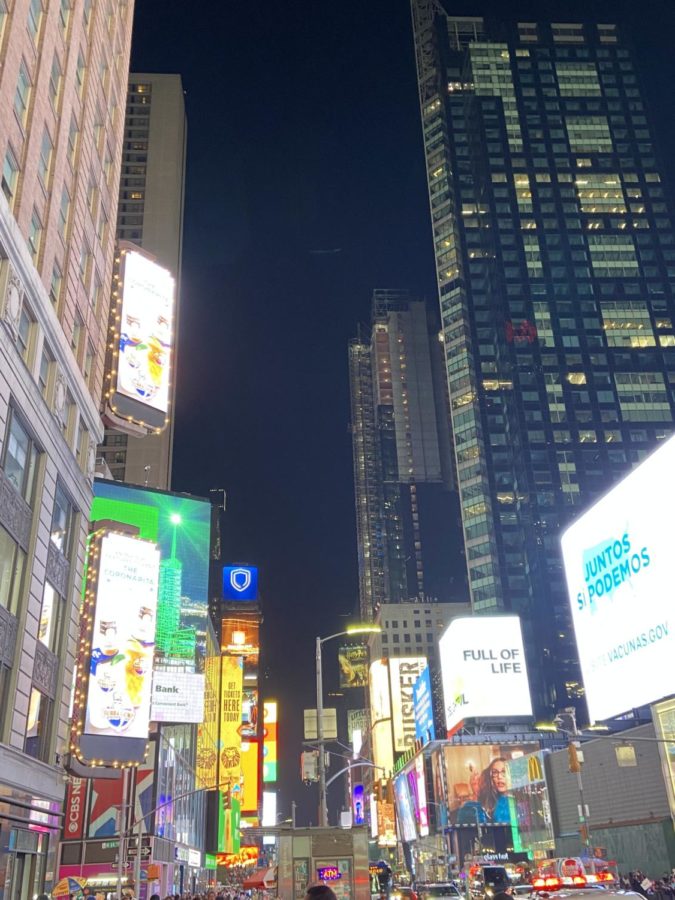Nuclear or Not? The Ups and Downs of Nuclear Power
New York’s Times Square is picturesque for its lights, but what powers the city that never sleeps?
May 18, 2022
High risk, high reward.
The saying applies to all corners of society: investments on Wall Street sealed within a handshake; the hypnotic lights and hazy music of a Vegas slot machine; even inching up to ten mph over the speed limit during your daily commute on Bastanchury constitutes a (ticketed!) risk exchanged for a dangerous prize of a quicker arrival. But on a greater scale, amidst an alarming climate crisis and a global explosion in energy demand, “high risk, high reward” fuels an electrifying debate on the usage of nuclear power to address these concerns. Let’s look at the how, the why, and the why not of nuclear energy.
What produces nuclear energy? The process begins when uranium, an abundant chemical element, is split apart by neutrons in a plant’s nuclear reactor (nuclear fission). The chemical reaction breaks apart the uranium atom into two, releasing heat and more neutrons. These newly-born neutrons ricochet and cleave apart more uranium atoms, kickstarting a chain reaction of uranium fission that releases immense amounts of heat as a byproduct.
The released heat boils a tank of nearby water into steam, and the water vapor is funneled into a nearby vessel with a turbine generator. The steam rotates the turbine, which drives its attached generator to produce energy. The steam is then condensed back into liquid water, where it is pumped back to the nuclear reactor to await another chain of nuclear fission.
By understanding the production of nuclear energy, it’s easier to understand its benefits – especially when compared to conventional methods of energy production like fossil fuels (gas, petroleum, coal). In this department, nuclear energy wins out; 1 gram of uranium-235 contains 2-3 million times the stored energy of 1 gram of coal, the most potent fossil fuel.
To top that off, uranium is a carbon-free source of energy and does not release any carbon dioxide byproducts. The combustion of conventional fossil fuels releases huge quantities of heavy metals and carbon dioxide gas – a greenhouse gas that traps heat in the atmosphere – which exacerbates global warming; hence, nuclear energy would not contribute to climate change and reduce the stress our energy production puts on Earth’s atmosphere. A booming population, greater demand for energy, and a challenging climate crisis – nuclear energy may help alleviate these issues.
Yet, nuclear energy production also contains significant cons. For one, the fuel sources used in nuclear reactions (often uranium, but also thorium and plutonium) are non-renewable heavy metals; they cannot be used infinitely, like many other alternative energy sources, and their extraction from the earth through mining has its own slew of environmental concerns.
Nuclear production also has dangerous byproducts. Used uranium fuel is extremely radioactive – radiation is known to damage organisms’ genetic patterns, causing cancer and dangerous genetic mutations – and nuclear waste remains radioactive for over 10,000 years. As such, nuclear waste must be stored away safely and disposed of with extreme caution to prevent radioactive leaks. The entire production process, then, starting from mining nuclear fuel to carefully controlling the rate of the powerful chain reaction to safely disposing of nuclear waste proves a complicated and expensive combination.
But nuclear’s most notorious negative lies in the dangers of nuclear accidents. Nuclear fission produces immense amounts of heat that can reach dangerously hot temperatures; nuclear fission also releases unstable chemical elements that are perilously radioactive and harmful to living organisms.
Infamous case studies include: Fukushima Daiichi in Japan, where a nuclear plant damaged by a tsunami released huge quantities of radiation into the atmosphere and leaked contaminated water into the ocean; Three Mile Island in Pennsylvania, where 50% of a nuclear reactor core melted down; and Ukraine’s Chernobyl disaster, where the meltdown of the reactor core released immense amounts of radiation into the air and contaminated huge swathes of surrounding European land. In the event of a nuclear accident, the societal and environmental fallout can instantly be devastating.
Environmentalists and policymakers thus must weigh the pros and cons of nuclear energy production in a world of accelerating climate change and industrial development. “People need to be more mindful of the problem of climate change,” Rebecca Kam (12) says. “Saving electricity, turning off the lights when you don’t need them, even eating vegetarian helps the atmosphere.” As delicately balanced ecosystems and food chains grow increasingly more disrupted from global warming and the greenhouse effect, the choice of “nuclear or not” may need to be made soon.





































